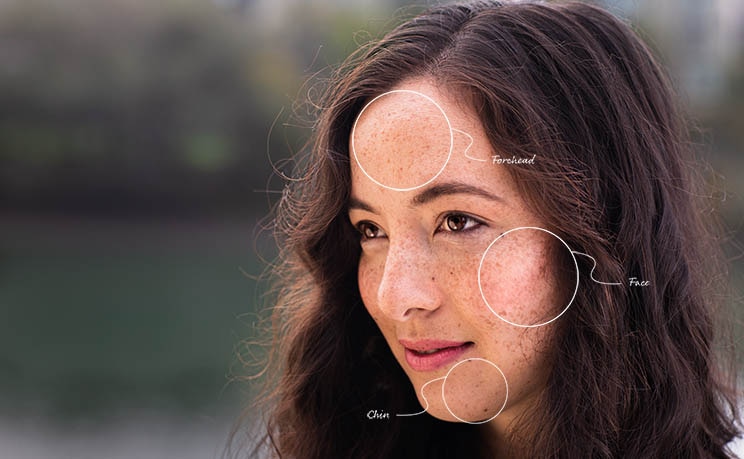AncestryDNA® Traits
Freckles
Some say freckles come from the kiss of an angel. But we know where most of them really come from. They come from genes. Or sun exposure. Or both. Even though they're most visible on people who have light skin, anyone can have freckles.
An AncestryDNA® + Traits test can tell you whether you're likely to have freckles according to your DNA. But what your DNA says isn't always what you see.


What Causes Freckles?
Freckles is the common term for ephelides and lentigines. These are the small concentrated areas of a pigment generated by the melanin in your skin cells. Melanin is the pigment that gives your hair, skin, and eyes their color.
In some people, the cells that make melanin (known as melanocytes) are spread out evenly throughout their skin. This means they tan well.
Others have melanocytes in clusters. It is these clusters of pigment-producing cells that show up as brown spots on your skin.
Freckles Genetics
Parents with freckles often have kids with freckles. But not always. This is because the inheritance of freckles is complex. There are many genes involved, and they can interact with one another in lots of different ways. Some gene combinations give freckles, some don’t. Some people also carry a genetic marker for freckles, but don't have brown spots.
For example, one gene, MC1R, is tied to both freckles and red hair. If both copies of the gene have the same genetic variant, then you’re a redhead. If only one copy has the variant, then you’ll get freckles—but not always. And scientists still don’t know why.
Ancestry scientists look at over 1,500 DNA markers they found are associated with freckling in order to predict if you have freckles. Many of these DNA markers are in genes that play a role in the production of melanin in some way. Many of the markers Ancestry scientists also look at affect how these genes work and so partially determine whether you will have freckles or not.
The Science of Freckles
There are also genetic and non-genetic factors involved in freckling. Between the two types of freckles, ephelides have a stronger genetic connection, while lentigines are caused more by environmental factors. Both freckle types, however, are influenced by environmental factors like extensive sun exposure.
One effect of sun damage, such as a sunburn, is to cause skin cells to produce extra melanin, leading to the appearance of those brown spots. But reduced exposure to the sun, like during the winter months, can cause freckles to fade.
Age spots or sun spots tend to appear in light-skinned older adults who have had a lot of sun exposure. They aren’t the same as freckles, although melanin does play a role in their pigmentation. Age spots are usually larger than freckles, but unlike the smaller freckles, which can fade over time with reduced sun exposure, the larger age spots don’t fade.
Fun Facts About Freckles
Newborn babies never have freckles. Freckles first show up in children when they're between two and four years old, because their skin needs a certain amount of time in the sun to start making those melanin spots, those "angels' kisses."
Freckles occur in people with heritage from around the world. Because they're often seen in people with red hair, freckles are commonly associated with Ireland and Scotland, where this hair color is common as well. But anyone can get freckles.
References
"Age spots (liver spots)." Mayo Clinic. Accessed July 3, 2023. https://www.mayoclinic.org/diseases-conditions/age-spots/symptoms-causes/syc-20355859.
Emerson, Sarah. "We Still Don’t Know Why Some People Get Freckles." Vice. April 6, 2016. https://motherboard.vice.com/en_us/article/aekebz/why-do-people-have-freckles.
Eriksson, Nicholas, et al. "Web-Based, Participant-Driven Studies Yield Novel Genetic Associations for Common Traits." PLoS Genetics. June 24, 2010. https://journals.plos.org/plosgenetics/article?id=10.1371/journal.pgen.1000993.
Gnanashanmugam, Devasena. "Ask a Geneticist: Other Traits." Stanford at the Tech Museum. October 20, 2006. http://genetics.thetech.org/ask/ask195.
Lalueza-Fox, Carles et al. "A Melanocortin 1 Receptor Allele Suggests Varying Pigmentation Among Neanderthals." Science. November 30, 2007. https://pubmed.ncbi.nlm.nih.gov/17962522/.
"MC1R." MedlinePlus. Accessed July 3, 2023. https://ghr.nlm.nih.gov/gene/MC1R.
Praetorius, Christian. "Sun-induced freckling: ephelides and solar lentigines." Pigment Cell & Melanoma Research. May 2014. https://pubmed.ncbi.nlm.nih.gov/24517859/.
Scott, Ellen. "This Is Why Some People Have Freckles." Metro. April 9, 2016. http://metro.co.uk/2016/04/09/this-is-why-some-people-have-freckles-5805863/#ixzz49nsgEUyI.
Sturm, Richard A. "Molecular Genetics of Human Pigmentation Diversity." Human Molecular Genetics. April 15, 2009. https://pubmed.ncbi.nlm.nih.gov/19297406/.